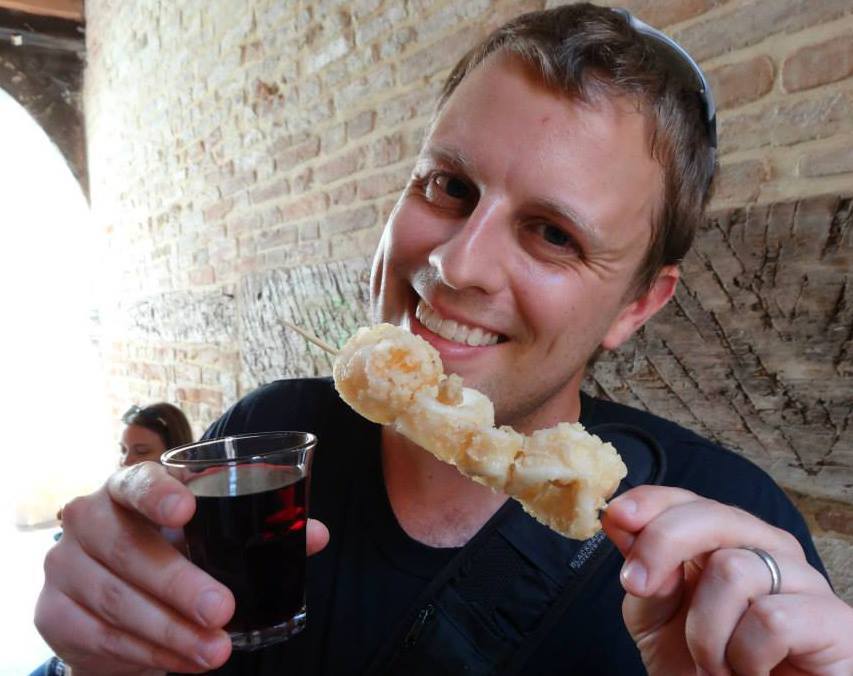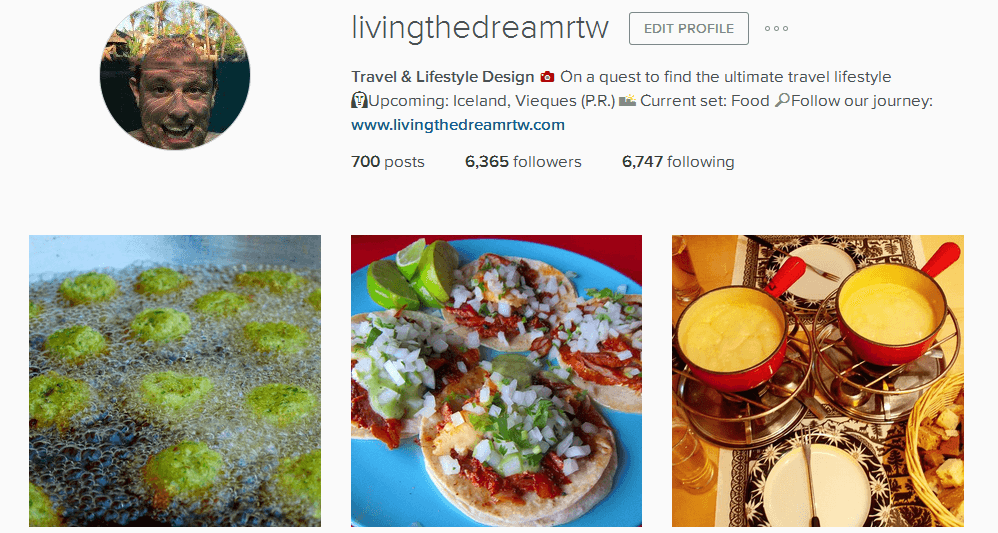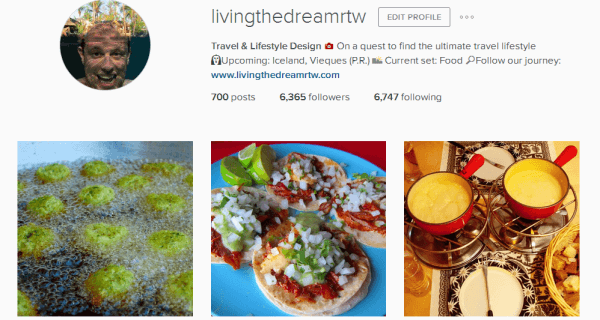Published by Jeremy. Last Updated on March 24, 2022.
Disclaimers: Our site uses demographic data, email opt-ins, display advertising, and affiliate links. Please check out our Terms and Conditions for more information. Listed prices and attraction details may have changed since our visit and initial publication.
For those who don’t know me, you should know that I am an engineer as well as a travel blogger- which at times is a very dangerous combination. When I try out something new to help my brand grow, I put together a test and log everything so I can get to the real reason for why something works. (We then write about it in our Blog Your Trip series to share it with you).
Over the past year I’ve been conducting many successful Instagram tests, and they’ve been picking up in popularity thanks to this social network’s continued rise in prominence.
As I’ve had some time to reflect on our most recent tests (find the one on Instagram hash-tags and the one on gaining targeted Instagram followers here), I need to tweak some of the recommendations I wrote about in those posts to form our game plan moving forward.
So, before reading any further, I highly recommend you read through both of those first. Finished? Good, let’s recap.
✈️ Book Your Next Trip
- • Planning a trip? Find a flight deal.
- • In need of a room? Check out hotel and apartment prices.
- • Taking a cruise? Find a cruise itinerary for your journey.
- • Don't overlook picking up a rental car or day tours as well!
Summary of Our Previous Tests
The two tests I performed looked at the effectiveness of Instagram hash-tags (something power users swear by), and techniques to try and grow your followers list (including, but not limited to, the shady following and unfollowing tactic most use but very few will admit to).
In the hash-tag test, I used my very young account to prove that hash-tags were worthless for new users. Adding any given tag onto an image may get you, as a new user, one or two likes per post if you are lucky- but you may pick up a follower every now and again which still makes them somewhat useful even if the return is incredibly low. (I’d love to repeat this test now that I have a bigger account, but unfortunately Instagram changed how the system is setup so it would be much harder to repeat.)
In the building follower’s test, I used a dummy account and proved that the biggest driver for growth on Instagram is being popular to begin with.
Depressing, right?
Generally speaking, popular/power user’s content performs better in Instagram’s algorithm than smaller users by default, yet power users never attribute their success to their size and often give other recommendations on how to grow that are just plain wrong.
To grow our account in this test, we performed targeted followings (and for a while, unfollowing, although we quickly stopped) and our rate of return followers was as high as 45%- greatly exceeding any recommended technique by power users. By the end of the study we reached over 6,000 followers on our test account, with 90%+ being organic follows- meaning our new followers not people we followed in the first place.
Two months later we were over 16,000 followers while not following a single new person at all. As this test was repeated on our account for Living the Dream with similar results (see screenshot above), we knew something was going on beyond users just following us in return.
What was it? We came to the conclusion that it was not only being popular, but also being popular and using relevant hash-tags and geolocations to our images.
Isn’t That What Power Users Recommend?
Yes, it is! This is the ironic thing about the entire study we performed is that most power user’s recommendations are actually spot on. But what most fail to realize is it only works if you’re popular to begin with.
As a new user you can follow techniques from popular users all you want, but they will not work. I feel like I need to apologize here because this is absolutely the case.
The difference between you using a popular hash-tag (and getting 5 likes on an image) versus a power user (getting 2,000 likes on an image) is that the power user’s fan base is going to get them the vast majority of those 2,000 likes regardless of the tags they use- and this makes a huge difference overall.
This phenomenon is independent of tags, having quality photos, using good Instagramming practices, and all of those standard recommendations that you typically see. The reason for this is simple. A large user’s base popularity will push their images up in the Explore tab and into any given tag’s/geolocation’s Top 9 simply because they have that base audience in place which will engage on any photo they publish.
What happens once they get better image placement in the Top 9 and Explore tab? Thousands more people see their photos. In turn, more people like their photos, and more people follow them. That simply will not happen to you at all because, as a new user, your network is not going to get there no matter how good your images are hash-tags are.
This is why our targeted following test worked so well. We kept increasing our following, our new fans liked a bunch of our images, our images got pushed to the Top 9 and Explore tabs for other users to see, and more users liked us organically. By the time we were hitting 200-300 likes per image (at roughly 5,000 followers on each account) we were pulling in 50-100 fans per day organically, all without following a single new user.
This is how you succeed in Instagram’s algorithm.
Using Instagram’s System to Become Popular
I know this is an ethical grey area, but when we repeated our following test on our Living the Dream account, we went from 1800 followers and 900 following to 6,500 followers an 6,800 following in just over two months. (For full disclosure, we unfollowed a grand total of zero accounts here as we are still trying to be as ethical about it as possible.)
Much like our dummy account, our followers went from being 99% users who we followed in the first place, to over 95% organic. This means that our content is starting to do the work for us, and our growth will be taking off even more in the future purely because our images are popular with our base audience to begin with.
There are many people out there who do not want to overwhelm their feed with images from 7,000 active users, and I get that. But to be honest I don’t mind. I targeted very specific users (travelers who recently followed other travel accounts), and these users are also posting content in my niche. My feed looks beautiful whenever I look through it even if it is busy, so I get enjoyment out of the network regardless.
I thoroughly believe that this method could work for anyone as long as you are smart about it (with the caveat being your gallery must be worth the attention to begin with), and getting that base number of followers is critical to make any future marketing work. But we’re not stopping there.
Although our plan is to continue to grow our accounts by letting Instagram’s algorithm continue to work for us, we are setting our sights on the next logical step now that we can no longer follow more users: using proper hash-tags and geolocations.
- Note: Since publishing this post we’ve moved away from the above ever-so-slightly. Following accounts is a good way to get real users to follow you in return and jumpstart engagement, but it may not last forever. Themed accounts like those from bloggers, influencers, and the like disproportionately close much faster than an average user in your target audience. As such, after a period of several years we saw our percentage of dead/closed accounts following us rise. As such, we removed a bunch of our following as well. We recommend the below as the primary approach these days even if the above may still work in the short-term.
Finding Hash-Tags and Geolocations that Work for You
Ah, right. I mentioned that using hash-tags and geolocations are a huge part in an account’s growth and that power users are right by this one but for the wrong reasons. Let’s talk about that.
Once you get that base interaction where your account grows regardless of any external work, you can supercharge it through targeted hash-tags and geolocations.
But, once again, there is a point that power users miss when they say to use relevant tags because they are either a) growing through their base popularity alone and b) not explaining the right reasons for why the tags are working for them.
Yes, you should use relevant tags. That’s just smart Instagramming. But you should also target tags that will help you get into the Top 9 for more exposure. Otherwise you’re still wasting the tag just like new users who slap the same hash-tags onto everything without getting any results. This is where a bit of research goes a long way.
What gets into the Top 9? Well, that depends on the tag and is easy to find out. After looking into some of the hash-tags I’ve used for ages, I found the following:
- #travel: 2,000 to 20,000 likes typically.
- #travelstoke: 2,000 to 10,000 likes typically.
- #natgeotravelpic: 2,000 to 10,000 likes typically.
- #traveldudes: 400 to 1,000 likes typically.
- #beautifulmatters: 2,000 to 8,000 likes typically.
Even with close to 7,000 and 16,000 followers on my accounts, with 200-400 or so likes per image, I can safely say I’m never going to get the benefit of being in the Top 9 in any of those tags- except for maybe #traveldudes (which has happened several times).
Sure, I could still use them to try and get featured by their parent accounts (@traveldudes also does a great job re-sharing), but that is rare enough as it is even for those who make it into the top spots. As far as I’m concerned, these are worthless unless you get enough likes on your images to rank in the Top 9, although I still tag some of them on the slim dream of being featured.
My plans are to not target these highly popular hash-tags because until we get to those number of likes the image is probably moving down the charts way too fast for anyone to notice it. One day we’ll get there, but it isn’t happening now. Instead, my goal is to target smaller tags that I can place into the Top 9.
This is the key piece of information that most forget to say when talking about effective hash-tag use. You have to use tags suitable for your account’s size!
Sure, smaller users will not find value in tagging categories that have millions upon millions of images. But tags that have tens of thousands or hundreds of thousands of images can be quite popular too, and it is one method for growth we think is completely ignored.
A few tags we found that fit this category for us include the following:
- #travelbloggers: 90,000 images and just 150 likes to get into the Top 9
- #travelzoo: 20,000 images and just 200 likes to get into the Top 9
- #getlostnow: 35,000 images and just 200 likes to get into the Top 9
I uploaded a few photos with these tags, and wouldn’t you know it? They all made the Top 9 almost immediately. Want to know what else happened? Our overall engagement rate went up too.
It isn’t huge, but I’ll take an extra 5-10 likes per image per tag in a moderate channel than 1 like per image per tag with generic tags like we were getting- and that is if we were lucky.
If you spend as much time researching your keywords as big users do, keeping this one fact in mind is very, very important. Otherwise you’re contributing to popular tags that other people have created (and possibly making money off of) while getting no benefit in return for yourself.
I should take a step back here and point out that I’m not breaking these down to try and tell you what you should and should not tag on Instagram. That isn’t the point. The main highlight you should take away is that if you are targeting popular tags, and your account is not popular enough to play in it, the tag isn’t going to do much for you and you’re probably wasting your time.
If this is you, you’ll need to find other ways to grow your account or new tags to use altogether. Gain more followers via following other users. Find tags more relevant to your account’s size. Do something different. Get that first trigger for growth like we did, and stay the course until you can play in the league you’re shooting for.
If you don’t, you may otherwise keep spinning your wheels on Instagram like we were for many, many months.
Looking for great travel photos on Instagram? Follow us at Living the Dream for global travel and Discover the Burgh for local photos from Pittsburgh, PA!
Looking for more information on how to promote your blog? Click the previous link to learn all of our secrets! For more of our top blogging tips, check out our thoughts on blog names.
Have an existing blog that is in need of an upgrade? Check out the following services we personally use!
- BigScoots - Premium managed hosting with plans as low as $35/month.
- GeneratePress - A customizable theme designed for site speed.
- AdInserter Pro - A widget logic plugin that is quite powerful.
- WP Rocket - An image and caching optimization plug-in.
- Mailerlite - Cost effective newsletter service.
- Keysearch - Keyword research tool for SEO.
- Pretty Links Pro - A great link cloaking tool to clean up affiliate links.
About Jeremy

About the Author: Jeremy is a full-time travel writer based in Pittsburgh and primary author of this site. He has been to 70+ countries on five continents and seeks out new food, adventure activities, and off-the-beaten-path experiences wherever he travels.

